Get PeakVisor App
Sign In
Search by GPS coordinates
- Latitude
- ° ' ''
- Longitude
- ° ' ''
- Units of Length

Yes
Cancel
Share ×

Scan the QR code and open PeakVisor on your phone
❤ Wishlist ×
Choose
Delete
As the third largest island in the Mediterranean, located in a key position between North Africa, the Middle East, Anatolia, and the Greek islands, Cyprus has long been a land of significance. It was the storied birthplace of Aphrodite and Adonis, the home of the ancient Greek city state of Salamis, and a historical military or commercial base for no shortage of different empires and kings.
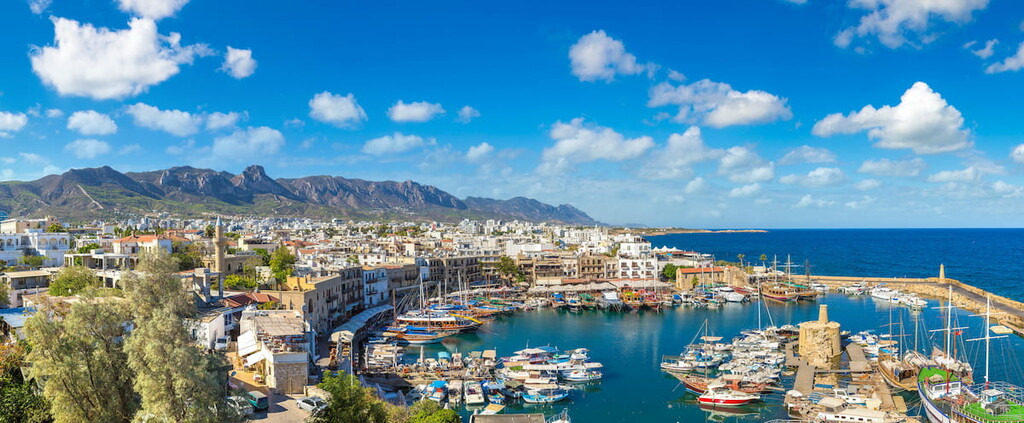
Today, the landscape of Cyprus is a mix of primarily Greek and Turkish cultures amid a modern Mediterannean country, with scenic beaches, vast plains of wildflowers and scrub, lush forest, and perhaps most importantly, around 381 named peaks, concentrated mainly in the Troodos and Kyrenia mountain ranges. The tallest and most prominent mountain is Mount Olympus, standing at 1,952m/6,404ft above sea level with a prominence just the same.
Cyprus is notable as the third largest island of the Mediterranean Sea, located in the Eastern
Basin just 75km/47mi south of Turkey or, more specifically, the Anatolian peninsula. To its direct east is Syria, with Lebanon and Israel southeast, Egypt in the south, and islands of Greece in the west.
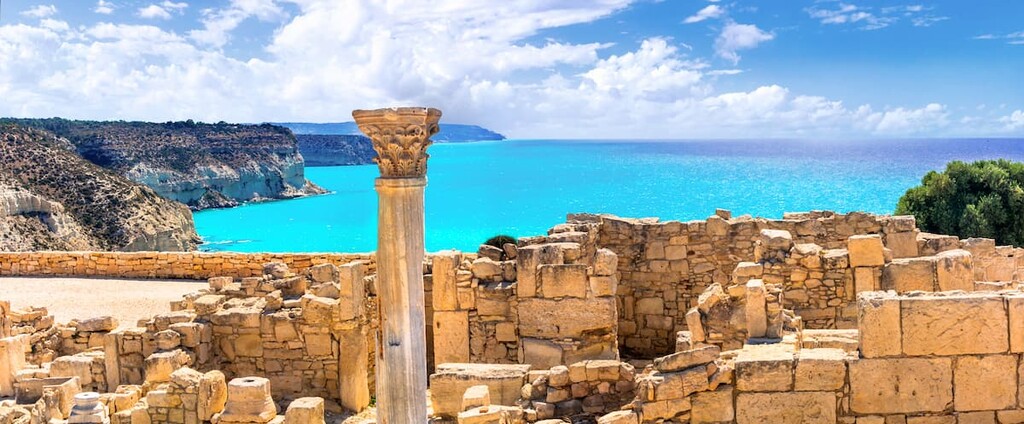
The landscape of Cyprus is best defined by the Troodos Mountain Range near the center of the island, easily recognizable on a satellite map by its vast expanse of green and rugged mountain peaks. The Troodos range is home to Mount Olympus in the district of Limassol, the tallest and most famous mountain of Cyprus. To the southwest of Troodos, the mountains give way to stepped foothills, eventually reaching coastal plains along Cyprus’ southwestern shore.
The other notable mountain range is the narrow Kyrenia Range, running along the northern border of the island until it reaches the Karpass Peninsula that juts out to the Levant, where the mountains become foothills. Its highest peak is Mount Selvili at 1,024m/3,360ft above sea level, and it is home to the Pentadaktylos or “five-fingered” peak, named for its resemblance to a hand.
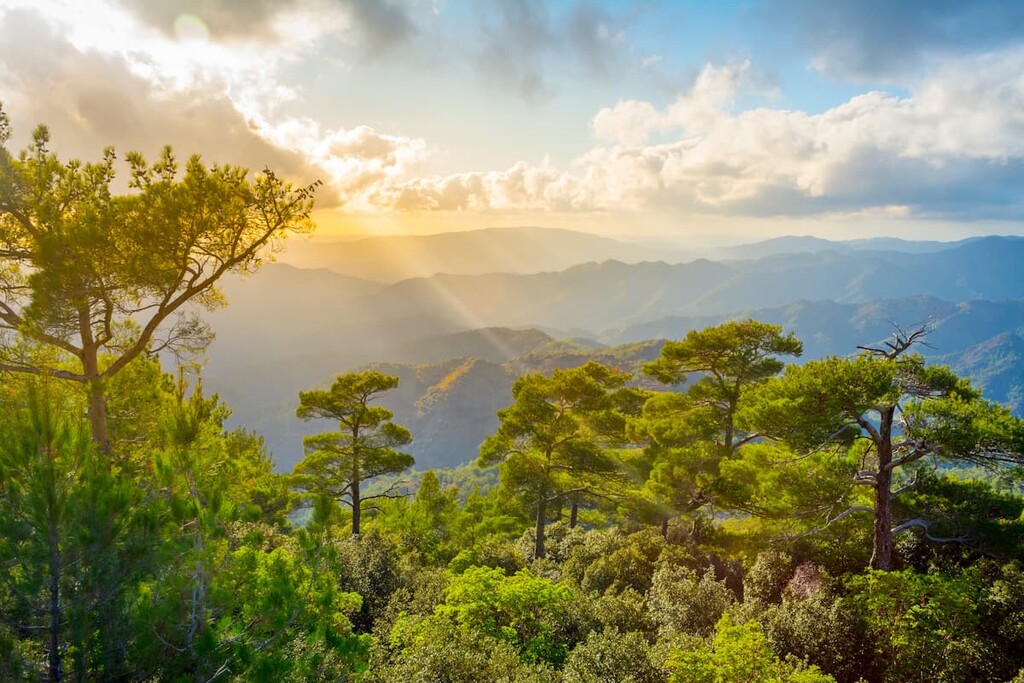
Between the two ranges is the Mesaoria, a vast, bare plain that occupies north-central Cyprus toward the east coast and Bay of Famagusta.
Year-round freshwater is limited on the island, mainly supplied by winter rivers flowing out from the Troodos Mountains, which become dry during the summer, and by the winter rainfall. The longest river is the Pedieos River which flows to Bay of Famagusta.
Cyprus’ climate is largely Mediterranean in nature, though it is notably warmer than its other European Union counterparts in the Mediterranean, with dry, warm-to-hot summers, and wet, mild winters, especially along the coast. Snow can only occur high up on the Troodos Mountains.
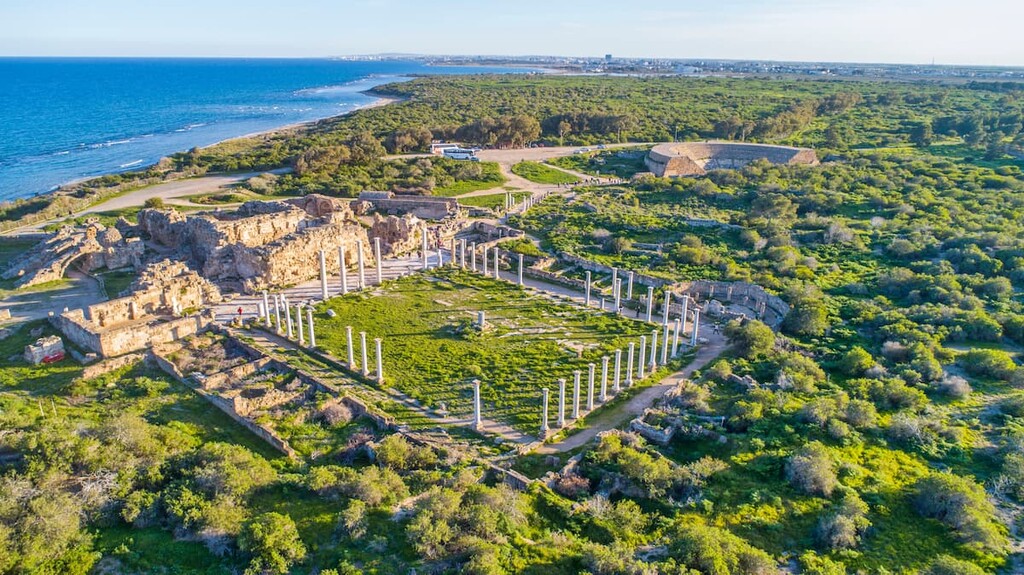
The warm season occupies most of the year from April to November, after which the temperature still remains rather temperate, with its lowest, night-time temperatures usually no lower than 6º C/43 ºF. Cyprus receives very high amounts of sunlight compared to other parts of the European Union, even in the winter.
Precipitation occurs mostly along the cool, high peaks of the mountains, with rain falling in smaller volumes along the plains and foothills, and great variation in rainfall between the years.
Cyprus has an interesting administrative layout, with six districts belonging to the country of Cyprus, including the district of Nicosia, wherein its largest city and capital resides, and the district of Limassol, wherein the second largest city of Limassol arrives, as well as the districts of Kyrenia, Famagusta, Paphos, and Larnaca.

Additionally, however, the island is home to several exclaves and non-Cypriot military bases within the Sovereign Base Areas of Akrotiri and Dhekelia. There is also a United Nations-controlled buffer zone stretched along the northeastern section of the island, splitting the city of Nicosia in two, which effectively separates the island into Greek Cypriot and Turkish Cypriot spheres of control but does not prevent travel between them, as the zone can be crossed.
The creation of the island of Cyprus itself is owed to the collision of the Anatolian Plate, which Cyprus lies along the southern margin of, with the African plate. By virtue of its location along a plate margin, earthquakes are a fairly frequent phenomenon on the island.
Cyprus consists of four named bedrock units, known as the Keryneia Terrane, Troodos Ophiolite, Circum Troodos Sedimentary Succession, and Mamonia Terrane.
The geographically northernmost of these is the Keryneia Terrane, extending from Cape Kormakitis eastward to Cape Andreas, on the tip of the Karpass peninsula. Keryneia is a largely sedimentary sequence (particularly of carbonate rocks) that dates back to the Permian.
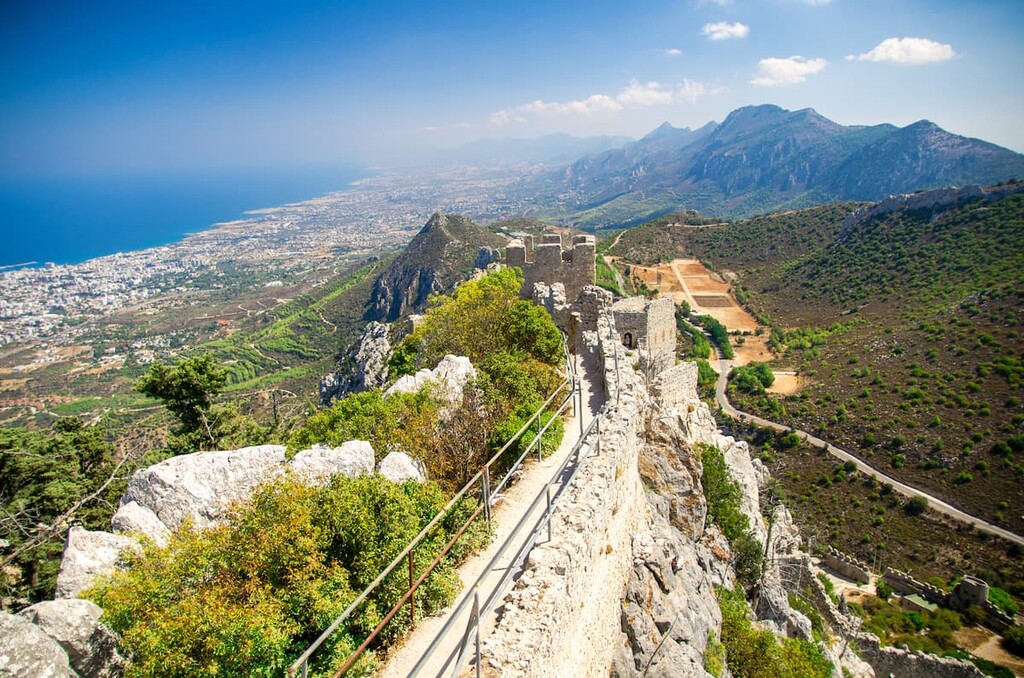
The Kyrenia Range of northern Cyprus is a sequence of sedimentary formations consisting largely of folds of Mesozoic limestone and, to a lesser extent, marble, created from a collision between the African and Eurasian plates.
To the south of Keryneia is the Troodos Ophiolite, an undisturbed Late Cretaceous sequence of ophiolite (oceanic crust uplifted via subduction), igneous rock (namely basalt, andesite, dunite, and dacite), and sedimentary rock (shales and radiolarite) that make up Cyprus’ famed Troodos Mountain Range. Formations of dikes and pillow lava, named for their characteristic pillow-shaped appearance, can also be found in the range.
Around the Troodos range is the circum Troodos sedimentary succession, massive outcrops of sediments that comprise most of Cyprus. In southwestern Cyprus are outcrops of volcanic, metamorphic, and sedimentary rock known as the Mamonia Complex, likely deposited between the Triassic and Cretaceous.
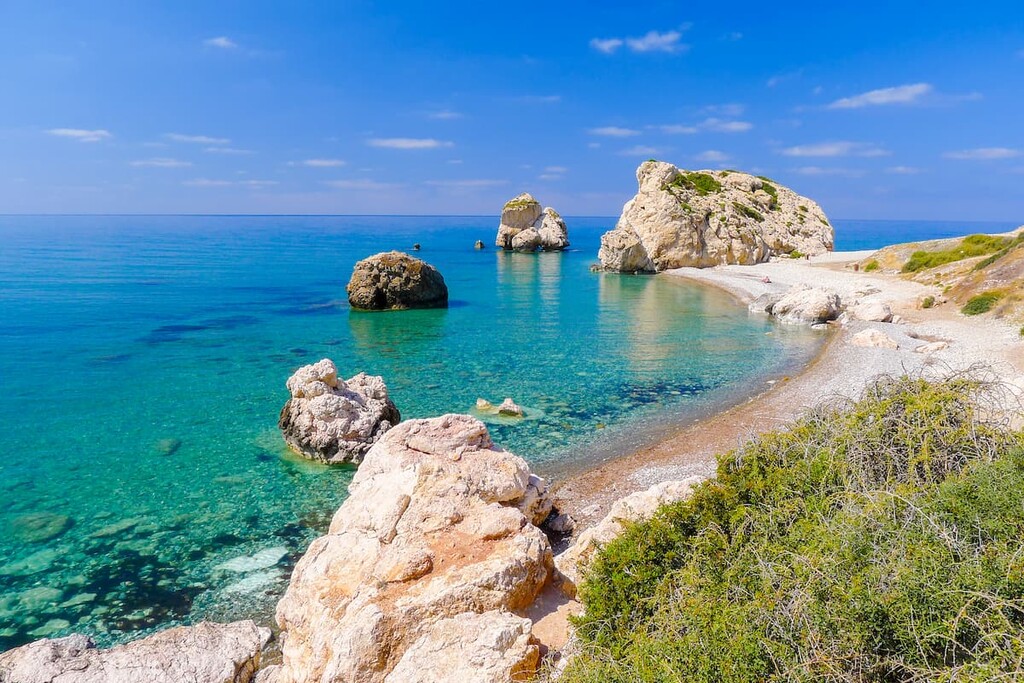
In terms of other notable geological features, Petra tou Romiou, otherwise known as Aphrodite’s Rock is a famous sea stack in southwestern Cyprus with great mythological significance.
The ecological landscape of Cyprus is mainly defined by the presence of Cyprus Mediterranean forests ecoregion, supporting varied and diverse plant communities. One such community is a type of Mediterranean low shrubland known as garrigue (or phrygana), composed of often aromatic plants like thyme, lavender, sage, cistus, and sparse juniper or oak trees.
Cyprus tulips, Loch’s glory-of-the-snow, yellow star-of-Cyprus, and Troodos cat-mint, among many others, are other examples of the great, diverse, and incredibly endemic flower and herb populations on the island. The Mesaoria Plain, especially from autumn to spring, is especially abundant in wildflowers and shrubs.
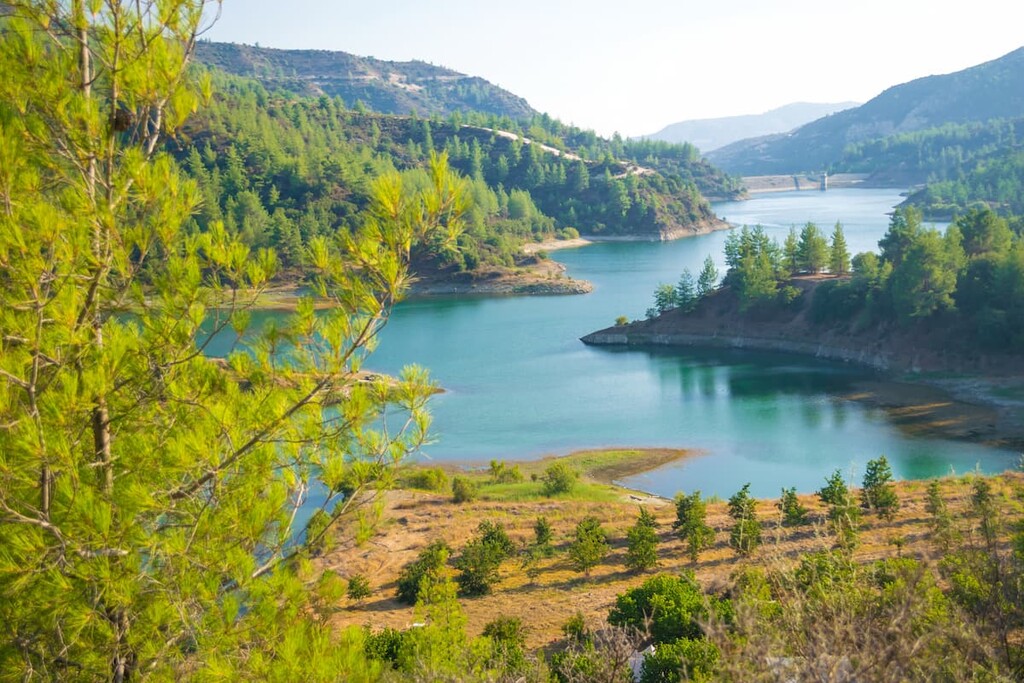
High evergreen shrublands, known as maquis, are similar in nature but thicker and denser, with a prevalence of heather and trees like the holm oak. Besides the shrublands, Cyprus contains grasslands, open woodlands, and, especially in the mountains, conifer and broadleaf forests. The Cyprus cedar and golden oak are of particular note, as they are both endangered and endemic to the island of Cyprus and, specifically, the Troodos Mountains, which contains the Paphos Forest reserve.
Within the Paphos Forest are the aforementioned cedar and oak, as well as other trees like the Brutia pine and Old World sycamore, and notable animals like the endemic Cyprus mouflon and Cyprus mouse, and the red fox, a common sight in much of the general region. Other mammals to be found on Cyprus include fruit bats, hedgehogs, Balkan pond turtles, whip snakes, and starred agamas.
Cyprus is home to nearly 400 species of birds, some of which are endemic and will only breed on the island, like the Cyprus warbler, Cyprus wheatear, and Cyprus scops owl. The black-winged stilt, spur-winged lapwing, greater flamingo, chukar partridge, and griffon vulture are other significant avifauna, often found near the sea and other bodies of water like Cyprus’ Limassol and Larnaca salt lakes.
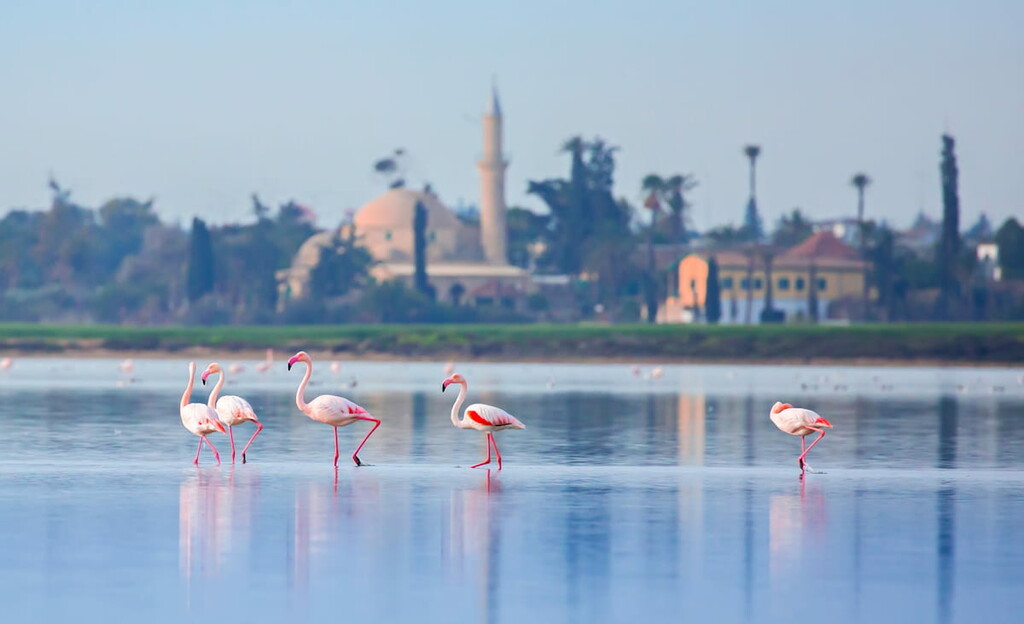
Of course, as Cyprus is surrounded by water, there is no shortage of marine life, either. Green sea turtles, loggerhead sea turtles, and Mediterannean monk seals like to breed along Cyprus’ shores.
The first evidence of human presence on the island dates back to around 10,000 BC, likely groups of hunter-gatherers who eventually established settlements around 2,000 years later. Neolithic villages would pop up throughout the next several thousand years, including a grave from 7500 BC containing both a human body and a cat, suggesting relationships between humans and cats even before such was seen with the ancient Egyptians.
The Greek world first interacted significantly with Cyprus around 1400 BC, when a group of Mycenaean traders began to visit. After the Bronze Age collapse, during which Mycenaean Greece fell into chaos and disorder at the end of the 1000s, many Greeks came to Cyprus to establish more permanent settlements. There is likewise textual evidence that Cyprus was visited by Phoenicians around that time.
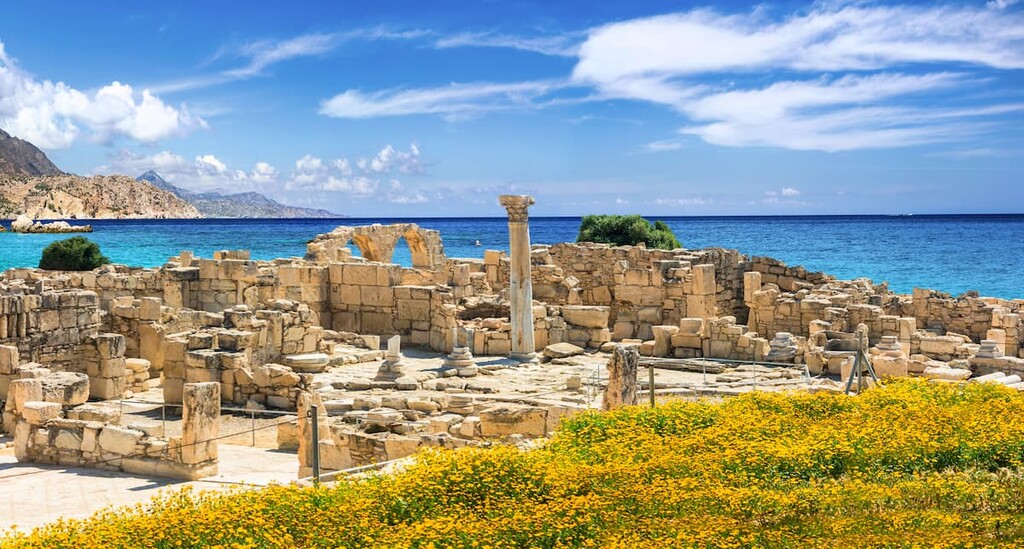
Cyprus began to take on a distinctly Greek character, and even became a notable place in Greek mythology, as a birthplace and/or home to figures like Aphrodite, Adonis, and Pygmalion. Owing to its excellent strategic location, the island fell under the rule of various empires like the Assyrians, Egyptians, and Persians, but continued to ally and associate with other Greeks and had a considerable amount of autonomy.
In the mid-300s BC, Cyprus, like much of the surrounding area at the time, was conquered by Alexander the Great, and later doled out to the Hellenistic Ptolemaic Kingdom after his passing, cementing its Greek nature. In 58 BC, however, it fell to the expanding Roman Empire, and at the end of the 4th century AD, it became part of the Byzantine Empire following the Roman Empire’s split.
The influence of the Byzantines resulted in a unique cultural blend of Byzantine Orthodox Christianity and Hellenism. Many of the Byzantine churches that would attest to this fact faced unfortunate demises at the hands of attacks from peoples in the Levant, starting in the 7th century, during which time cities were destroyed and people killed.
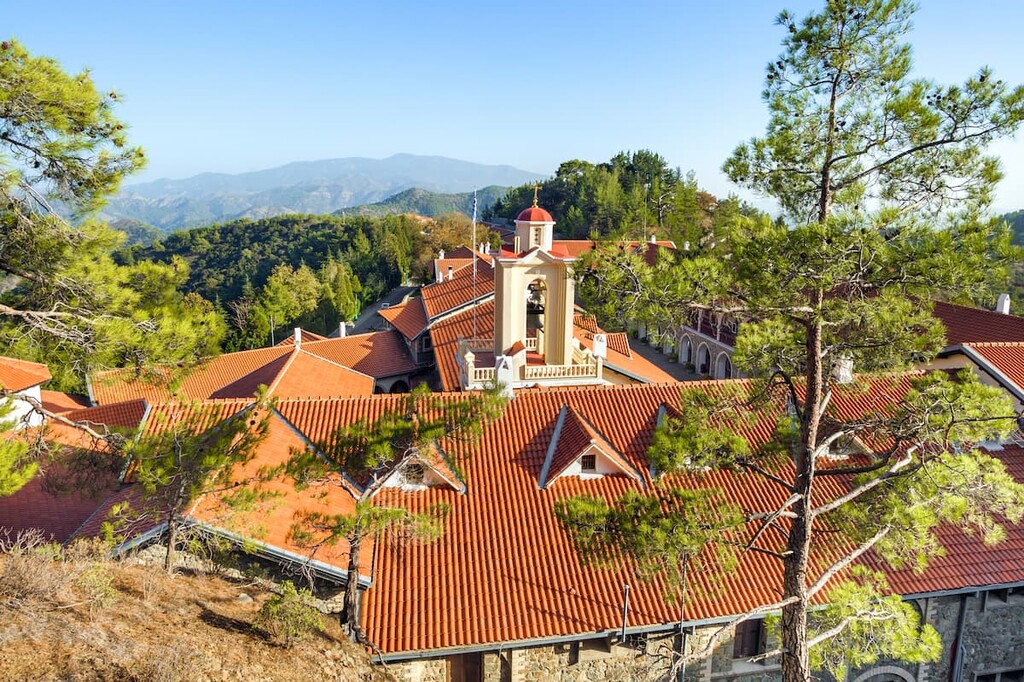
After three centuries of these raids, Emperor Nikephoros II reinstated Byzantine rule, only for it to be lost in 1191 at the hands of Richard I of England as part of the Third Crusade. Indeed, Cyprus was a highly sought-after territory throughout human history, changing hands endless times, often used as a commercial hub or, during times of war, a safe place to store supplies.
The next time would occur with the purchase of the island by the Knights Templar and then Frenchman Guy of Lusignan, who purchased it after a violent revolt against the Knights. After that was the Republic of Venice in 1473, during which time the famous and still-standing Walls of Nicosia were built.
The Ottoman Empire conquered Cyprus in 1570 and ignited the first major demographic change in thousands of years, introducing large Muslim and Turkish communities to the island, and changing the economic structure from classic feudalism to the Ottoman millet system, which could range from indifferent and relaxed in nature to oppressive depending on the time.
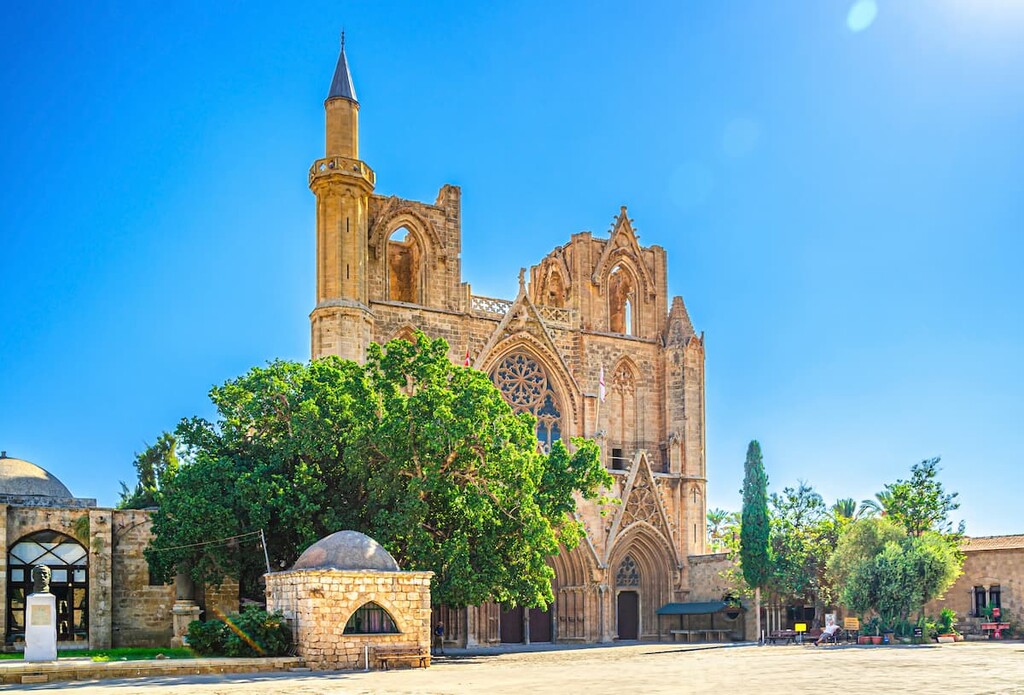
Ties to Greece still prospered, however, as some Greek Cypriots supported and even fought with Greeks in their 1821 war of independence, prompting arrests of many notable Greek Cypriots by the Ottomans. Tensions were further fueled by Greek president Ioannis Kapodistrias stating a desire to unify Cyprus with Greece, which many Cypriots agreed with as they faced poverty under the Ottomans and sought to sate Greek nationalist sentiments.
This would not come for quite some time. In 1878, Cyprus was leased and eventually became a protectorate to the British Empire after the Russo-Turkish War, becoming a significant British military base as they expanded their colonial influence to south Asia and Africa.
During the 1900s, Greek Cypriot desire for unity with the mainland, known as enosis, grew more fervent, which was seen as unfavorable for the Turkish Cypriots, who sought their own self-determination on the island. In the 50s, while Greece made unification part of its national policy, Turkey declared Cyprus to be a part of Anatolia to be united with Turkey instead.
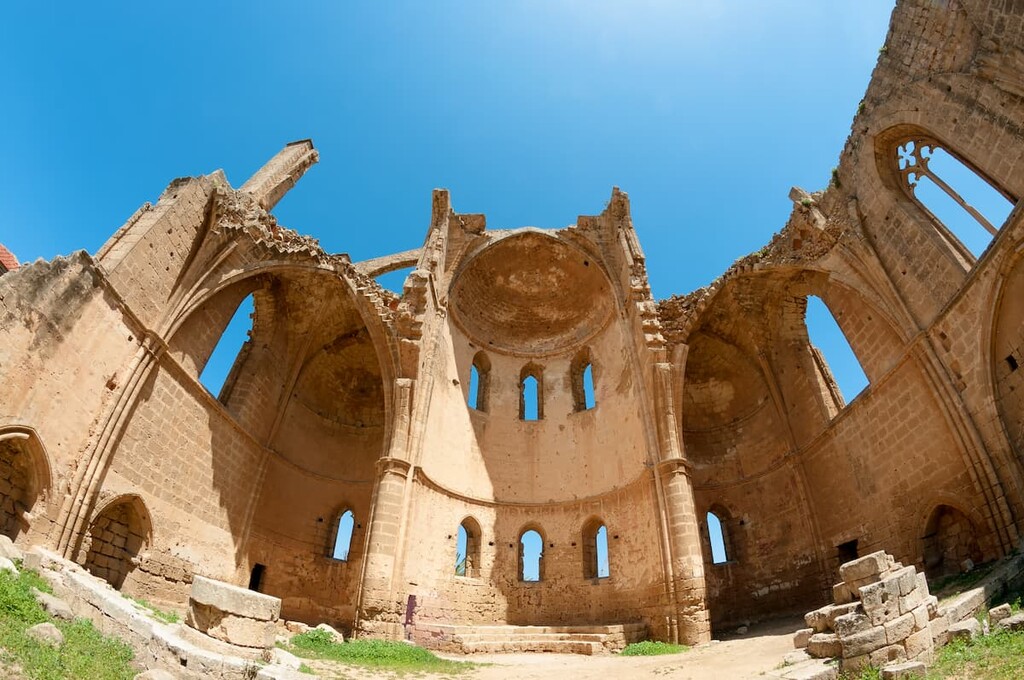
Knowing this was implausible, however, as the Turkish Cypriots were a minority on the island, many started to support partition, or taksim, instead. Once Cyprus got its independence in 1960, these tensions continued with strength and often turned violent. Attempts at enosis persisted by the Greeks, best seen in the 1974 Greek coup, and threats of invasion persisted by the Turks, who invaded Cyprus in response to the coup.
After years of violence through the 60s and 70s, Cyprus ended up virtually split between the Turkish Cypriots in the north and northeast, and the Greek Cypriots in the center, west, and south, with a buffer zone between them. In the 21st century, border restrictions slowly began to decrease, allowing for greater movement between the two, though reunification talks have so far been unsuccessful.
The forests and rock formations of Troodos National Park represent the splendor of Cyprus’ most famous mountains in all their glory, highlighted by the grand peaks of Mount Olympus. Along its trails are an abundance of birds, waterfalls, glimpses of the ophiolite complex that comprise much of the mountains, and, perhaps, the occasional mouflon.
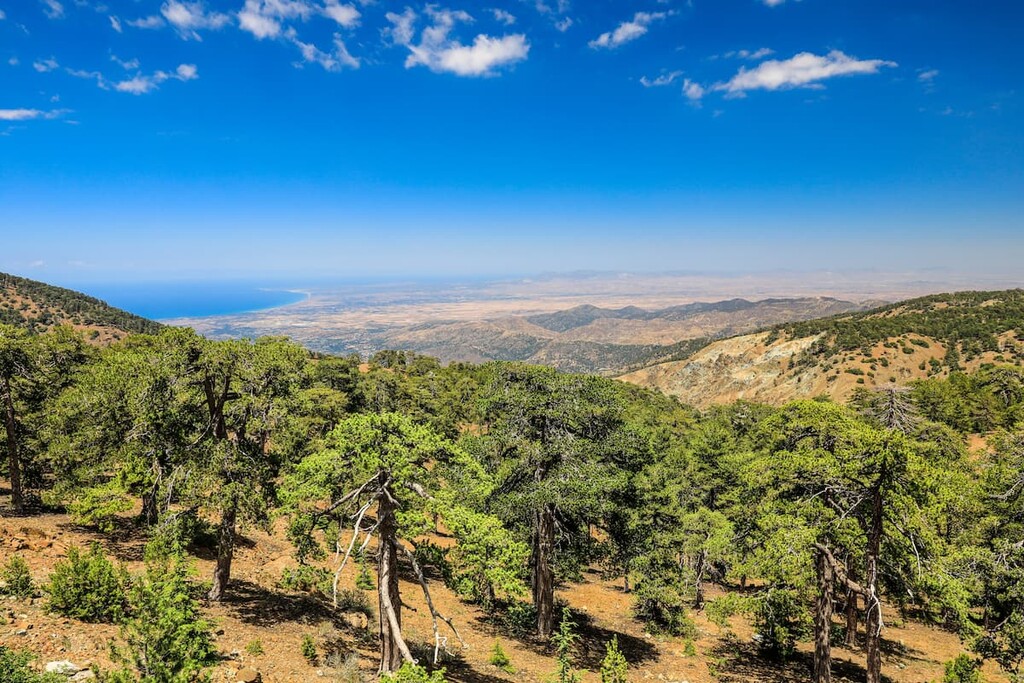
The park offers over 60km/37mi of trails for hiking, including the 14km/8.7mi Atalanti trail, which provides grand views of the entire island. The 7km/4.3mi Artemis trail is another one of note, winding through black pine forests and reaching some of the many historical and archaeological sites of the Troodos mountains.
On the southeastern tip of Cyprus is Cape Greco (or Greko) National Forest Park, a stunning example of the crystalline beaches, seaside cliffs of limestone, and piney forests that can be found along Cyprus’ coast. Cultural touchstones, like the birthplace of Aphrodite, Profitis Elias chapel, and Agioi Anargyroi Church, among others, likewise make the park worth experiencing.
There are several interconnected nature trails within the park, with some popular ones including the 8.5km/5.3mi Profitis Elias - Konnoi Trail leading to the Profitis Elias chapel, with panoramic views of the sea and landscape, the 4km/2.5mi Agioi Anargyroi - Thalassines Spilies trail, from which one can explore and dive around the park’s unique sea caves, and the 2km/1.2mi Aphrodite Trail, to the fabled birthplace of the goddess herself.
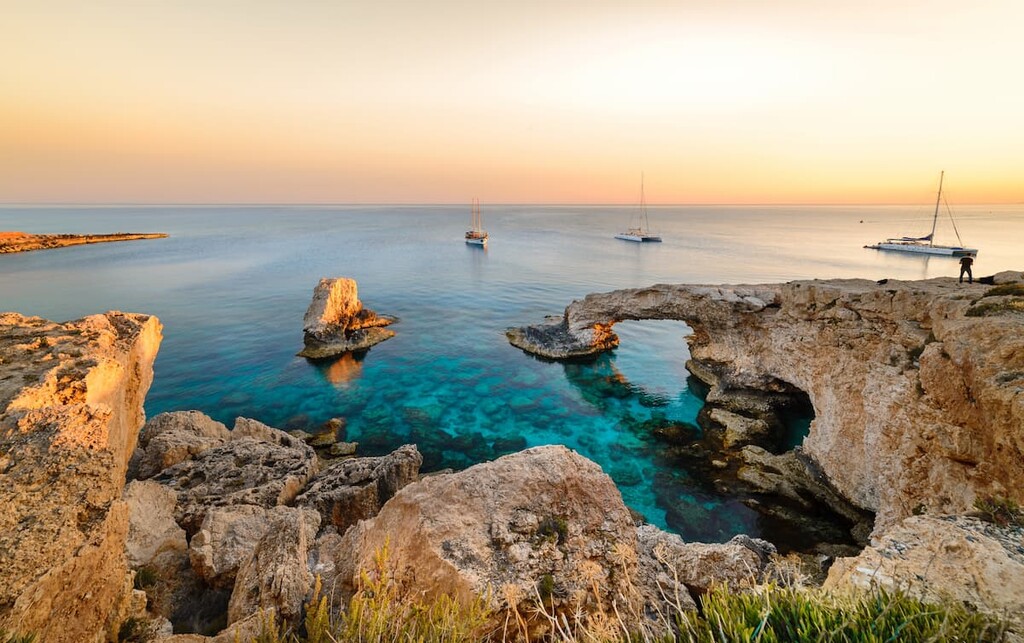
Other notable trails include:
Amid the forests of the Troodos Mountains is Machaires National Forest Park, a notable ecological site with lively animal populations and thick green forest, flowing streams, and freshwater springs. Snakes, lizards, endemic butterflies, and birds like the Scops owl, Cyprus warbler, coal tit, and many others reside within the park.
The park has several nature trails totalling to around 19km/11.8mi in length, with one of the most prominent being the Machairas Politikou trail, a 5.5km/3.4mi trail from the 12th-century Machairas monastery to the historical Gregory’s Afxentiou Monument that offers panoramic views of the landscapes and, during the winter, glimpses of stunning seasonal waterfalls.
The Akamas peninsula, in northwestern Cyprus, is an optimal site for witnessing the natural and historical beauty of the island, with its beautiful coastline, forested cliffs, unique rock formations, and dramatic gorges and valleys.
There are plenty of trails in the region, with some prominent ones being the 7.5km/4.7mi Adonis Trail that starts at the Baths of Aphrodite, a natural grotto tucked under a massive fig tree, and the likewise 7.5km/4.7mi Aphrodite Trail, which sees the Baths of Aphrodite as well as the Queen’s Tower, believed to belong to a medieval monastery.
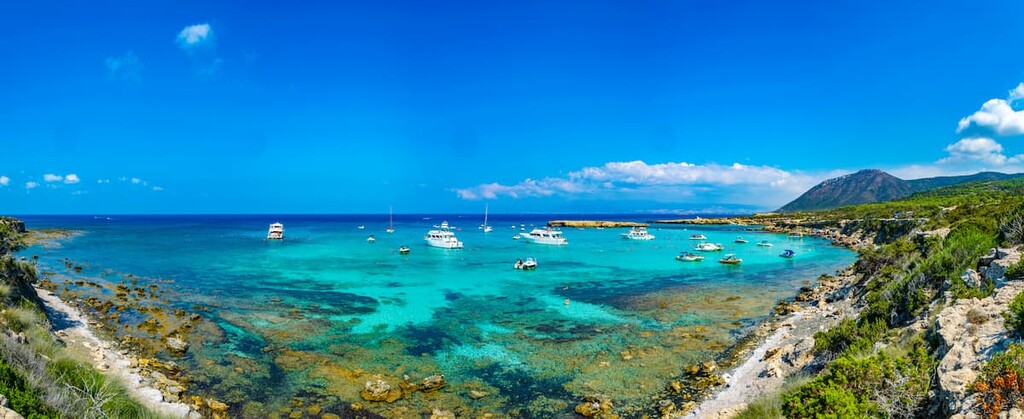
Athalassa National Forest Park is a popular hiking and cycling location for the capital city of Nicosia, where a 20km/12.4mi trail network offers stunning and overwhelmingly green walks through local flora and fauna.
Other notable hiking locations in Cyprus, though certainly not the full extent of all Cyprus has to offer, include:
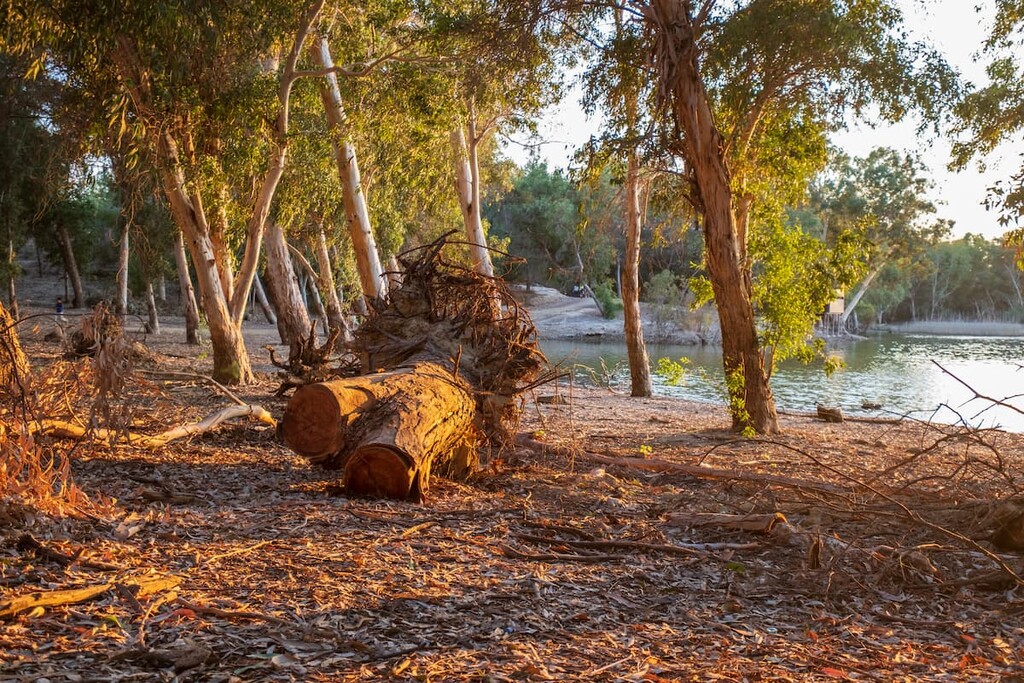
The cities of Cyprus, most frequently dotted about the island’s coasts, commonly boast stunning beaches and vistas, as well as a wealth of historical, architectural, and archaeological significance, from the Ancient Greeks to the Byzantines to the Ottomans and everything in between and after.
Located along the buffer zone is Cyprus’ second and largest city of Nicosia, with around 245,000 people within its urban limits. Because of the buffer zone, the city is split into a Greek and Turkish half, but there are several checkpoints through which one can cross between the two sides, the most popular perhaps the one at the bustling shopping center of Ledra Street.
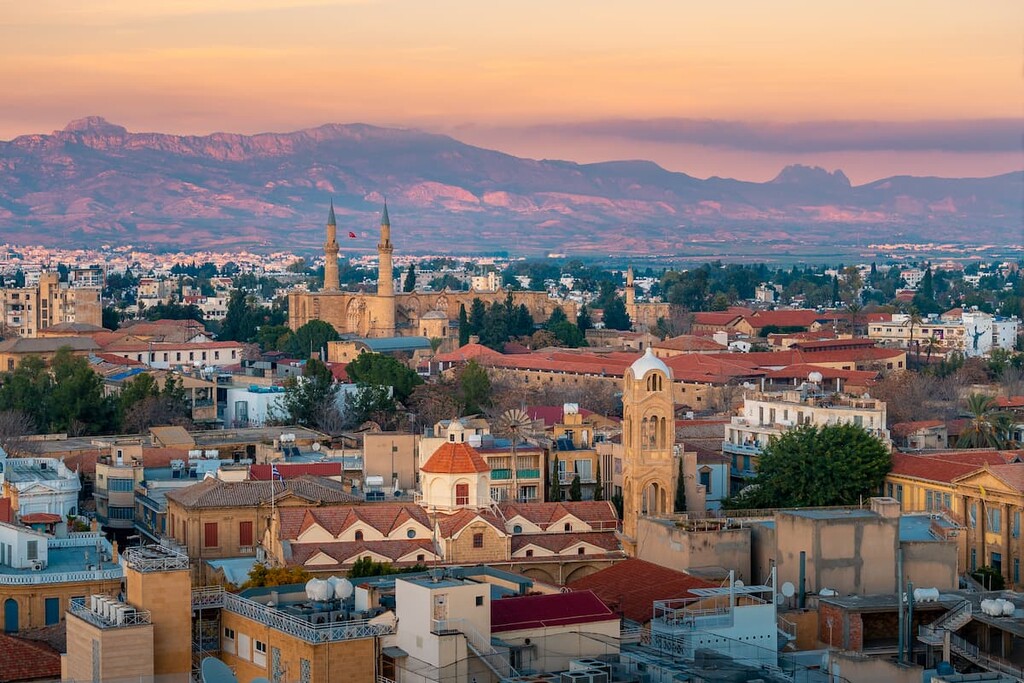
Nicosia teems with millennia of history, epitomized by the old city center and the Venetian walls that surround it. The old city’s Museums, Byzantine churches, traditional Turkish and Greek architecture, Ottoman mosques and baths, and open-air markets form a lively amalgamation of the different cultures who have inhabited Cyprus throughout its extensive history. Of course, there is no shortage of such features outside the old city as well, scattered throughout Nicosia.
The Cyprus Museum is the country’s oldest archeological museum, with an astounding collection of artifacts. Offshooting from the main roads and plazas, narrow streets hide hidden gems both traditional and modern in nature, such as boutiques, cafés, and restaurants with a melting pot of different cuisines.
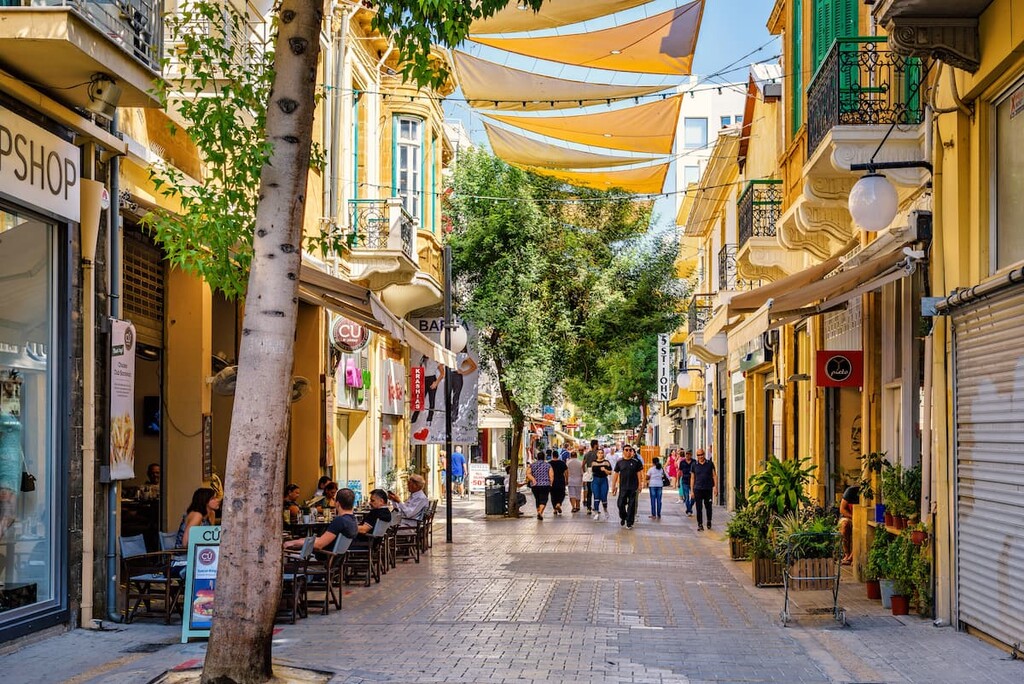
The city is connected to the rest of Cyprus through the country’s vast highway network, with buses that connect to the international airports of Larnaca and Paphos. Inside the city, buses are the best available public transportation, though there are taxis for service as well.
As the second largest city of Cyprus, with a metropolitan population of around 240,000 people, Limassol is a growing tourist destination with a prime location on the southern coast, with the sea, the Troodos Mountains, and Cyprus’ wine regions all within reach. The beaches, ports, and marinas of Limassol are of particular note, which many frequent for swimming, sunbathing, boating, and nightlife.
The impressive age of the city shows in its historic landmarks, like the medieval Limassol castle. Cyprus’ history can also be seen through Limassol’s many museums, like the Archaeological Museum, the natural history museum by the Municipal Garden, and the Folk Art Museum, displaying significant Cypriot Folk Art from the past few centuries.
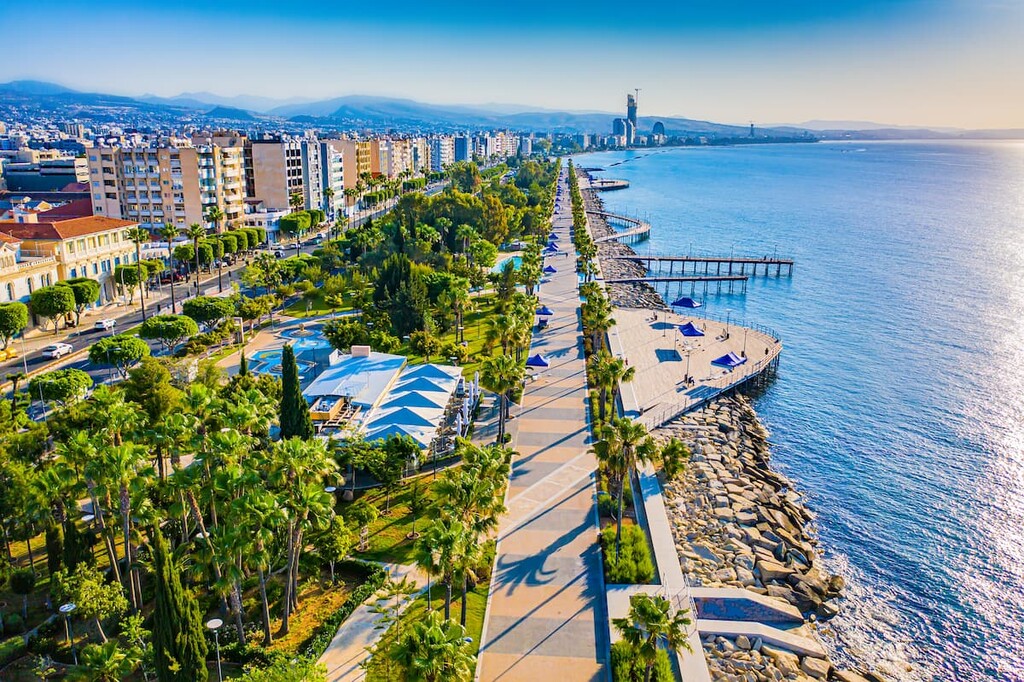
Moreover, Limassol is the host of many cultural and artistic festivals, including the Wine Festival of Cyprus, the famous Limassol Carnival, one of Cyprus’ oldest folk celebrations, the Festival of Ancient Greek Drama, and many more throughout the year.
Highways and intercity buses connect Limassol with the rest of Cyprus, with buses operating within the city as well. The two closest international airports are Larnaca and Paphos, both about 50km/31mi from the city proper.
Explore Cyprus with the PeakVisor 3D Map and identify its summits.








